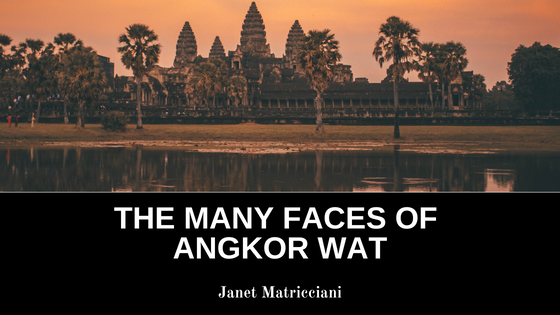Siem Reap, in northern Cambodia is today what Saigon or Bangkok would have been in 1970 – a few intersecting streets that comprise a dusty town. The whole area could be circumlocuted in an hour by foot – but nobody travels around this town aside Angkor Wat in that manner, when plenty of tuk-tuks (basically motorbikes with benches behind for carrying passengers) will take you anywhere in town for one dollar (currency in the area is entirely US dollars) and the sidewalks are disastrously higgledy-piggledy.
My stay in the FCC (Foreign Correspondents’ Club) was meant to be cool and trendy, but in fact was relatively boring in a perfectly decent but humid room adjacent to the pool, made bearable by lashings of mosquito spray morn, noon and night. I found myself peering wistfully in the windows of the warm and well-lit Victoria Hotel and the Raffles’ acquisition, Grand Hotel d’Angkor. Still, FCC is not a bad place to say for a short visit to the deservedly famous temples of Angkor Wat.
There are many quality restaurants in Siem Reap – check out Abacus, run by a surly Frenchman (what a cliché), with absolutely delicious food and even an onsite magician. There are also many very decent cafes for lighter fare – Pub Street is backpacker heaven, with its outdoor drinking and dining choices. Le Tigre de Papier (also presumably run by a Frenchman, but I didn’t meet him) there has good pizza and omelettes, as well as a run of beers and snacks. The outdoor restaurant at the FCC itself is perfectly reasonable, if not exciting. All the restaurants have nightly or weekly Cambodian dance shows which is perfect for the tourists.
Less perfect for the tourists is the Siem Reap War Museum. Only $5 to go in, plus several metaphorical dollars worth of hassle by the local guides if you decide not to use them on your visit. The museum is basically a large field, filled with burned-out armoured relics of the war: tanks, grenade launches, and lots and lots of guns you can touch and pretend to fire (my 8 year old son would have loved this place), with no explanations whatsoever beyond maximum speed, date of build and weight.
Angkor Cultural Village is fun (there’s a model of the Royal Palace at Pnomh Penh, so if you’re not going there, you can pretend like you did with some careful photography), and several different village and house styles (from the outside but you can’t go in), and a waxwork museum of life in Cambodia over the last century.
Angkor National Museum is good (the audio guide is excellent), but you will have seen a lot of similar stuff at Angkor Wat if you go there first. And do go there first. It is quite amazing. The best way is to rent bicycles and drive from temple to temple, but tuk-tuks and taxis willingly take the effort (and exercise) away from you, if so desired.
The main building of Angkor Wat (meaning “City Temple”) is reknown for its amazing friezes of battles, history, and the Mahabaratta. These three-dimensional stone wall carvings are incredibly intricate and beautiful – and long. They cover the faces of the temple along the entire walls: soldiers, horses, chariots, weapons. The best choice is to get up early to watch sunrise from a seated position on one of the walls at Angkor Wat and then to tour the complex. Go early so you don’t have to wait to climb up the central building as a queue soon develops, and the view from the top, with the greenness of the trees contrasting with the grey stone of the buildings, is worth the short climb.
Each temple in the complex has its own special quality. Ta Prohm is special mostly for the amazing old trees growing out of the walls, it feels like the jungle has taken over a city abandoned in haste. I think it was used for Tomb Raider as the guide called every tree “the Angelina Jolie tree”, which soon became a standing joke for my travelling companion and myself.
For sunset, my strong recommendation is not to go to Angkor and be with the crowds, but rather to go to Prae Rup. This temple has wonderful carved lions on the corners of the stairs, seeming to look out in all directions as proud owners over their lands. But be careful climbing – unlike Mexico, where some of the fun has been taken out of visits to Mayan temples by the restrictions on climbing or touching, at Angkor it’s a free-for-all. This makes it greatly enjoyable and a personal experience, but also means that one false move would mean a short-term stay in the local hospital, or possibly worse.
Baphuon was only just re-opened, after restoration by the French, and the giant three-dimensional reclining Buddha built into the wall is quite impressive. And the Elephant Terrace has, as you might imagine, many carvings of elephants in groups and singly, in various states of repair.
One other temple that is particularly wonderful – and different – is Bayon Wat. Giant heads are carved into the roof structures and stare out serenely in every direction. And everywhere is a great photo opp. No matter what you do, you will look like Ansel Adams. Email the photos home, and impress your friends – you won’t easily get an international phone connection for your cell in Siem Reap, so I recommend the internet route.
Go now, before the masses. The one million tourists who come a year is not yet overwhelming, though some of the main buildings do get a little crowded. But numbers are increasing at twenty-five percent a year as the relative stability of the political situation in Cambodia encourages international tourism, so the moment is now. Go soon and enjoy!

